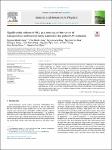Thông tin tài liệu
Thông tin siêu dữ liệu biểu ghi
| Trường DC | Giá trị | Ngôn ngữ |
|---|---|---|
| dc.contributor.advisor | Chu, Manh Hung | - |
| dc.contributor.advisor | Nguyen, Van Duy | - |
| dc.contributor.advisor | Nguyen, Duc Hoa | - |
| dc.contributor.advisor | Hoang, Si Hong | - |
| dc.contributor.advisor | Tran, Khoa Dang | - |
| dc.contributor.advisor | Nguyen, Ngoc Viet | - |
| dc.contributor.advisor | Le, Viet Thong | - |
| dc.contributor.advisor | Phan, Hong Phuoc | - |
| dc.contributor.advisor | Nguyen, Van Hieu | - |
| dc.contributor.author | Nguyen, Manh Hung | - |
| dc.date.accessioned | 2021-07-05T04:32:58Z | - |
| dc.date.available | 2021-07-05T04:32:58Z | - |
| dc.date.issued | 2021 | - |
| dc.identifier.uri | https://www.sciencedirect.com/science/article/abs/pii/S0924424721002223?via%3Dihub#! | - |
| dc.identifier.uri | https://dlib.phenikaa-uni.edu.vn/handle/PNK/1926 | - |
| dc.description | Q1 | vi |
| dc.description.abstract | A unique combination of high response and fast response-recovery is still a challenge in the development of room-temperature gas sensors. Herein, we demonstrated the on-chip growth of nanojunction-networked SnO2 NW sensors to work under UV-radiation at room temperature. The morphological, compositional, and structural properties of synthesized SnO2 nanowires were examined using field emission electron microscopy, energy dispersive spectroscopy, X-ray diffraction, and high-resolution transmission electron microscopy, respectively. The results presented the SnO2 NWs with smooth surfaces were entangled between the Pt electrode. Besides, the internal properties showed the SnO2 NWs were crystallized as the tetragonal rutile structure of SnO2. The use of UV-radiation with the optimum intensity of 50 μW/cm2 increased the gas response to 5 ppm NO2 up to 7-fold, while response and recovery times decreased about 8- and 4-fold, respectively. Moreover, alternative use of pulsed UV-radiation (provided only during the air recovery phase) can enhance significant gas response as compared with continuous UV-radiation. The enhancement of gas response could be attributed to the photo-adsorption and -desorption of NO2 molecule due to the photogeneration of electron-hole pairs. The combination of NW-NW nanojunctions and pulsed UV-radiation is expected to be a novel strategy for high-performance room temperature gas sensors. | vi |
| dc.language.iso | en | vi |
| dc.publisher | Sensors and Actuators A: Physical | vi |
| dc.subject | SnO2 nanowires | vi |
| dc.subject | Networked nanowires | vi |
| dc.subject | UV-radiation | vi |
| dc.subject | Gas sensors | vi |
| dc.title | Significantly enhanced NO2 gas-sensing performance of nanojunction-networked SnO2 nanowires by pulsed UV-radiation | vi |
| dc.type | Article | vi |
| eperson.identifier.doi | 10.1016/j.sna.2021.112759 | - |
| Bộ sưu tập | ||
| Bài báo khoa học | ||
Danh sách tệp tin đính kèm:

